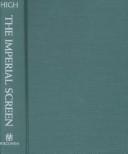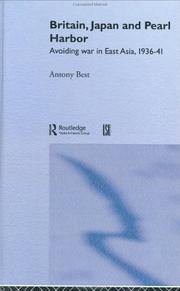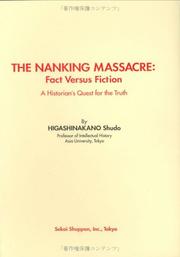| Listing 1 - 5 of 5 |
Sort by
|
Book
ISBN: 9789004227675 9004227679 9789004282599 9004282599 Year: 2015 Volume: 14 Publisher: Leiden Boston Brill
Abstract | Keywords | Export | Availability | Bookmark
 Loading...
Loading...Choose an application
- Reference Manager
- EndNote
- RefWorks (Direct export to RefWorks)
In this groundbreaking study of a subject intricately tied up with the controversies of Japanese wartime politics and propaganda, Maki Kaneko reexamines the iconic male figures created by artists of yōga (Western-style painting) between 1930 and 1950. Particular attention is given to prominent yōga painters such as Fujita Tsuguharu, Yasui Sōtarō, Matsumoto Shunsuke, and Yamashita Kiyoshi—all of whom achieved fame for their images of men either during or after the Asia-Pacific War. By closely investigating the representation of male figures together with the contemporary politics of gender, race, and the body, this profusely illustrated volume offers new insight into artists’ activities in late Imperial Japan. Rather than adhering to the previously held model of unilateral control governing the Japanese Empire’s visual regime, the author proposes a more complex analysis of the role of Japanese male artists and how art functioned during an era of international turmoil.
Painting --- Iconography --- anno 1930-1939 --- anno 1940-1949 --- Japan --- Painting, Japanese --- Sino-Japanese War, 1937-1945 --- World War, 1939-1945 --- Men in art. --- War in art. --- Propaganda, Japanese. --- Western style Japanese painting --- Yōga (Japanese painting) --- Japanese propaganda --- Male figure in art --- World War, 1939-1945, in art --- Chinese-Japanese War, 1937-1945 --- Japan-China War, 1937-1945 --- Japanese-Chinese War, 1937-1945 --- Second Sino-Japanese War, 1937-1945 --- Sino-Japanese Conflict, 1937-1945 --- Western style. --- Propaganda. --- Foujita, Tsugouharu, --- Yasui, Sōtarō, --- Matsumoto, Shunsuke, --- Sōtarō, Yasui, --- 安井曽太郎, --- 安井曾太郎, --- Foujita, Léonard, --- Foujita, Tsuguharu Léonard, --- Fujita, Reonāru, --- Fujita, Tsuguharu, --- Fujita, Tsuguji, --- Tengtian, Sizhi, --- 藤田嗣治, --- 松本峻介, --- 松本竣介, --- Criticism and interpretation.

ISBN: 0299181340 0299181308 9780299181345 Year: 2003 Publisher: Madison, Wis. University of Wisconsin Press
Abstract | Keywords | Export | Availability | Bookmark
 Loading...
Loading...Choose an application
- Reference Manager
- EndNote
- RefWorks (Direct export to RefWorks)
Film --- anno 1930-1939 --- anno 1940-1949 --- Japan --- Culture in motion pictures --- Motion pictures --- Sino-Japanese War, 1937-1945 --- World War, 1939-1945 --- J3384 --- J4150.80 --- J6800.80 --- J6839 --- World War, 1939-1945, in motion pictures --- Chinese-Japanese War, 1937-1945 --- Japan-China War, 1937-1945 --- Japanese-Chinese War, 1937-1945 --- Second Sino-Japanese War, 1937-1945 --- Sino-Japanese Conflict, 1937-1945 --- History --- Motion pictures and the war --- Japan: History -- Gendai, modern -- Shōwa period -- World War II (1931-1945) --- Japan: Sociology and anthropology -- cultural history -- Gendai (1926- ), Shōwa period, 20th century --- Japan: Performing and media arts -- history -- Gendai (1926- ), Shōwa period, 20th century --- Japan: Media arts and entertainment -- cinema

ISBN: 0415111714 Year: 1995 Publisher: London ; New York Routledge
Abstract | Keywords | Export | Availability | Bookmark
 Loading...
Loading...Choose an application
- Reference Manager
- EndNote
- RefWorks (Direct export to RefWorks)
History of Asia --- anno 1940-1949 --- anno 1930-1939 --- Japan --- China --- China-Japan War, 1937-1945 --- Chinees-Japanse oorlog, 1937-1945 --- Chinese-Japanese Conflict, 1937-1945 --- Chinese-Japanese War, 1937-1945 --- Conflit sino-japonais, 1937-1945 --- Deuxième guerre sino-japonaise (1937-1945) --- Guerre de résistance contre le Japon (1937-1945) --- Guerre sino-japonaise, 1937-1945 --- Japan-China War, 1937-1945 --- Japanese-Chinese Conflict, 1937-1945 --- Japanese-Chinese War, 1937-1945 --- Kang-Ri zhanzheng (1937-1945) --- Pearl Harbor [Aanval op, 1941 ] --- Pearl Harbor [Attack on, 1941 ] --- Pearl Harbor [Attaque sur, 1941 ] --- Second Sino-Japanese War, 1937-1945 --- Seconde guerre sino-japonaise (1937-1945) --- Sino-Japanese Conflict, 1937-1945 --- Sino-Japanese War, 1937-1945 --- Sino-japonaise [Guerre ] (1937-1945) --- East Asia --- Foreign relations --- Great Britain --- World War, 1939-1945 --- Causes

ISBN: 4916079124 4916079132 9784916079121 9784916079138 Year: 2005 Publisher: Tokyo: Sekai Shuppan,
Abstract | Keywords | Export | Availability | Bookmark
 Loading...
Loading...Choose an application
- Reference Manager
- EndNote
- RefWorks (Direct export to RefWorks)
Nanking Massacre, Nanjing, Jiangsu Sheng, China, 1937. --- Sino-Japanese War, 1937-1945 --- Nankin, Massacre de, 1937 --- Guerre sino-japonaise, 1937-1945 --- Atrocities --- Atrocités --- Nanking Massacre, Nanjing, Jiangsu Sheng, China, 1937 --- Sino-Japanese Conflict, 1937-1945 --- Nanjing Shi (China) --- History --- Atrocities. --- History. --- S04/0825 --- J3386.20 --- J4850 --- China: History--War against Japan: 1931/1937 - 1945 --- Japan: History -- Gendai, modern -- Shōwa period -- World War II -- war with China -- Nanking massacre (1937) --- Japan: International law -- law of peace and war (including war crimes) --- Atrocités --- Nanking --- Bloedbad van Nanking, Nanjing, Jiangsu Sheng, China, 1939 --- Massacre de Nanking, Nanjing, Jiangsu Sheng, China, 1939 --- Nanking Massacre, Nanjing, Jiangsu Sheng, China, 1939 --- Nanjing --- Nan-ching ta tʻu sha, Nanjing, Jiangsu Sheng, China, 1937 --- Nanjing da tu sha, Nanjing, Jiangsu Sheng, China, 1937 --- Nanking Massacre, Nan-ching shih, China, 1937 --- Rape of Nanking, Nanjing, Jiangsu Sheng, China, 1937 --- Massacres --- Nanjing, Battle of, Nanjing, Jiangsu Sheng, China, 1937 --- Tu pan Nan-ching shih cheng kung shu (China) --- Nan-ching shih (China) --- Nan-ching shih jen min cheng fu (China) --- Nanjing (China : Municipality) --- Nankin-shi (China) --- Nanjing te bie shi shi zheng fu (China) --- 南京市 (China) --- History of Asia --- anno 1930-1939 --- Sino-Japanese Conflict, 1937-1945 - Atrocities --- Nanjing Shi (China) - History
Book
ISBN: 9780691140315 0691140316 9786613012128 1400838606 128301212X 9781400838608 Year: 2011 Publisher: Princeton: Princeton university press,
Abstract | Keywords | Export | Availability | Bookmark
 Loading...
Loading...Choose an application
- Reference Manager
- EndNote
- RefWorks (Direct export to RefWorks)
In their earliest encounters with Asia, Europeans almost uniformly characterized the people of China and Japan as white. This was a means of describing their wealth and sophistication, their willingness to trade with the West, and their presumed capacity to become christianized. But by the end of the seventeenth century the category of whiteness was reserved for Europeans only. When and how did Asians become "yellow" in the Western imagination? Looking at the history of racial thinking, Becoming Yellow explores the notion of yellowness and shows that this label originated not in early travel texts or objective descriptions, but in the eighteenth- and nineteenth-century scientific discourses on race. From the walls of an ancient Egyptian tomb, which depicted people of varying skin tones including yellow, to the phrase "yellow peril" at the beginning of the twentieth century in Europe and America, Michael Keevak follows the development of perceptions about race and human difference. He indicates that the conceptual relationship between East Asians and yellow skin did not begin in Chinese culture or Western readings of East Asian cultural symbols, but in anthropological and medical records that described variations in skin color. Eighteenth-century taxonomers such as Carl Linnaeus, as well as Victorian scientists and early anthropologists, assigned colors to all racial groups, and once East Asians were lumped with members of the Mongolian race, they began to be considered yellow. Demonstrating how a racial distinction took root in Europe and traveled internationally, Becoming Yellow weaves together multiple narratives to tell the complex history of a problematic term.
Racism --- Race awareness --- East Asians --- National characteristics, East Asian --- History --- Race identity --- National characteristics, East Asian. --- Race identity. --- S11/1200 --- S02/0300 --- S03/0240 --- J4129 --- China: Social sciences--Anthropology, ethnology (incl. human palaeontology): general and China --- China: General works--Chinese culture and the West and vice-versa --- China: Geography, description and travel--Travels: 1500-1840 --- Japan: Sociology and anthropology -- cross-cultural contacts, contrasts and globalization --- Bias, Racial --- Race bias --- Race prejudice --- Racial bias --- East Asian national characteristics --- Prejudices --- Anti-racism --- Race relations --- Awareness --- Ethnopsychology --- Ethnic attitudes --- Asians --- Ethnology --- Sociology of minorities --- History of Asia --- anno 1700-1799 --- anno 1800-1899 --- Critical race theory --- Carl Linnaeus. --- China. --- Chinese. --- Down syndrome. --- East Asian bodies. --- East Asians. --- Far East. --- Franois Bernier. --- Japan. --- Japanese. --- Johann Friedrich Blumenbach. --- Mongolian bodies. --- Mongolian eye. --- Mongolian race. --- Mongolian spot. --- Mongolian. --- Mongolianness. --- Mongolism. --- Sino-Japanese War. --- Tartar. --- Tom Pires. --- Wilhelm II. --- anatomical quantification. --- anthropology. --- color top. --- homo sapiens. --- human taxonomies. --- medicine. --- merchants. --- missionaries. --- race. --- racial thinking. --- racism. --- skin color. --- travel narrators. --- whiteness. --- yellow peril. --- yellow race. --- yellow. --- yellowness. --- Racism - Western countires - History - 18th century --- Racism - Western countires - History - 19th century --- Race awareness - Western countries - History - 18th century --- Race awareness - Western countries - History - 19th century --- East Asians - Race identity
| Listing 1 - 5 of 5 |
Sort by
|

 Search
Search Feedback
Feedback About UniCat
About UniCat  Help
Help News
News